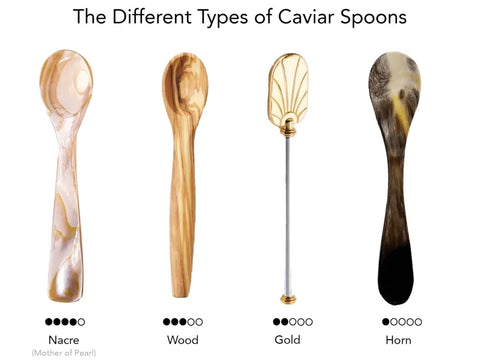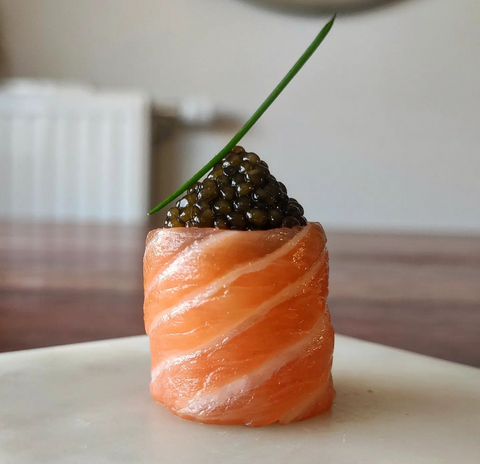Masago and tobiko, both prized fish roe in Japanese cuisine, differ in their origins, with masago originating from capelin fish, displaying a milder taste and an orange colour, while tobiko hails from flying fish, showcasing vibrant colours and a distinctive popping texture.

In this guide, we’ll walk you through all the differences between the two, explain each type individually and even include some awesome and short educational videos about each fish. Enjoy!
Masago vs Tobiko Comparison
| Tobiko | Masago | |
|---|---|---|
| Product | Fish egg (roe) | Fish egg (roe) |
| Fish Type | Flying Fish Family | Capelin (Smelt family) |
| Egg Size | Small (0.5 – 0.8 mm) | Extra Small (0.5 – 0.55 mm) |
| Texture | Firm, crunchy | Soft |
| Available Colours* | Yellow, black, green, orange, red | Yellow, orange, red |
| Natural Colour | Golden Yellow | Light Yellow |
| Nutritional Value | Protein, Omega-3, Vitamin D & B12, Selenium, Phosphorus + | Protein, Omega-3, Vitamin D & B12, Selenium, Phosphorus + |
| Price | Low | Very Low |
| Origins | Japan, Vietnam, China, Indonesia, India, Caribbean Sea + | Iceland, Norway, Russia, Alaska, Canada, Greenland + |
| Habitat | Warm waters | Cold waters |
| Scientific Name | Exocoetidae | Mallotus villosus |
Buy Tobiko & Masago Online
Are you looking for tobiko or masago in Canada? Check out our premium selection available in 3 different colours.
What is the difference between Tobiko & Tobiko?
Tobiko and masago, two prominent fish roe delicacies in Japanese cuisine, exhibit nuanced differences that add depth to their culinary applications:
Origin:
- Tobiko: Hailing from flying fish species, tobiko boasts a fascinating link to the agile marine creatures known for their remarkable leaps above the water’s surface.
- Masago: In contrast, masago finds its source in capelin, a small fish that inhabits cold waters.
Colour and Appearance:
- Tobiko: Tobiko’s allure lies in its kaleidoscope of captivating colours, ranging from vibrant orange and red to mesmerizing green and black. This visually arresting palette transforms it into a delightful garnish for an array of dishes, adding an artistic touch to culinary creations.
- Masago: Sporting a more consistent orange hue, masago possesses an appealing visual charm of its own, though its colour range is comparatively limited.
Texture and Flavor:
- Tobiko: With a pleasing, crunchy texture and subtle saltiness, tobiko offers a unique mouthfeel that pops with each bite, imparting a burst of flavour that accentuates the overall taste experience.
- Masago: Exhibiting a smaller size and a softer texture, masago delivers a milder, slightly sweet taste that harmonizes well with the other ingredients in the dish.
Health Benefits
Masago and tobiko share some nutritional similarities. They are both good sources of protein, omega-3 fatty acids, and various vitamins (D, B12) and minerals (selenium, phosphorus).
However, there might be slight differences between the two in terms of specific nutrient content, depending on the species of fish and their diet.
Culinary Versatility:
- Tobiko: Renowned for its multifaceted appeal, tobiko stands out as an exceptional garnish for sushi rolls, sashimi, and a myriad of seafood delicacies. Its vibrant colours and distinct flavour make it a favourite among chefs for enhancing both the visual and gustatory aspects of the dish.
- Masago: Similarly, masago enhances various culinary preparations, often gracing sushi rolls and seafood dishes. Its subtler taste complements the dish’s overall flavour profile while adding a touch of elegance to the presentation.
In the hands of skilled chefs and culinary enthusiasts, the use of tobiko and masago opens up a world of creative possibilities, allowing them to craft exquisite dishes that not only tantalize the taste buds but also enchant the eyes with their vibrant colours and visual splendour.
What is Tobiko (Flying Fish Roe)
Tobiko represents a distinct variety of fish roe hailing from flying fish species, prominently featured in Japanese gastronomy.

Boasting small, crunchy eggs, tobiko delights both the palate and the eyes with its remarkable range of vibrant colours, encompassing shades of orange, red, green, and black.
Esteemed for its captivating sensory attributes, tobiko enchants connoisseurs with its unique flavour and delightful popping texture. These qualities make it a favoured choice for enhancing the culinary experience of sushi rolls, sashimi, and an array of seafood delicacies.
The mesmerizing fusion of taste, texture, and aesthetics achieved by the presence of tobiko elevates the overall allure of the dish, appealing to the discerning palates of sushi enthusiasts and gourmands alike.
Check out this awesome video of flying fish graciously taking flight as they try to escape predators.
What is Masago (Capelin/Smelt Roe)
Masago refers to the roe, or eggs, of the capelin fish, a small species commonly found in the cold waters of the North Atlantic, North Pacific, and Arctic oceans.
It possesses distinctive characteristics, presenting as small, vibrant, and orange-hued beads. These eggs have a delicate flavour profile, exhibiting subtle sweetness and a pleasing crunch.

In culinary applications, masago finds widespread use in Japanese cuisine, particularly as a sought-after ingredient in sushi and other seafood-oriented dishes.
The incorporation of masago imparts not only an aesthetically pleasing appearance due to its colourful and petite structure but also enhances the overall taste experience.
From a nutritional standpoint, masago is notable for its richness in essential nutrients. It is a commendable source of protein, omega-3 fatty acids, and various vitamins, contributing to a well-balanced diet.
In certain instances, imitation masago can be found in the market, crafted from alternative seafood options to replicate the genuine capelin roe. The reason for this substitution often stems from challenges related to the limited availability and elevated cost of authentic masago.
Sources:
- Capelin – Fisheries and Oceans Canada (DFO)
- Flying Fish – The National Wildlife Federation
- Capelin (Mallotus villosus) distribution and climate – ICES Journal of Marine Science (Oxford Academic)
- Capelin in the Barents Sea – Institute of Marine Research





